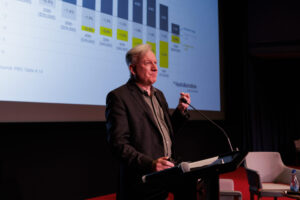by Ebony Bennett
[Originally published in the Canberra Times, 23 March 2019]
Australia has never had a federal treasurer who wasn’t a man and has had more finance ministers named John than female finance ministers. It doesn’t take an economics degree to know those numbers are a problem.
With the federal budget near, we learned this week that eight community organisations representing women, children, Indigenous Australians and people with disabilities would be excluded from this year’s budget lock-up. So we’re now excluding women from reporting on the budget, too.
Each year, the government and the Treasury invite their most relevant stakeholders into the lock-up. This year, many group representing women didn’t make the cut. It’s not hard to see how the lack of women’s voices and representation will affect debate.
Government pre-election sweetener likely on back of iron price boom.
When times are good and we cut taxes, men mostly benefit. When times are tough and services are cut, the burden falls mainly on women. After the horror 2014 budget, Australia Institute research found that 55 per cent of the burden of budget cuts fell on women. Men received twice as much as women from income-tax cuts during the mining boom a few years earlier. Remember, those tax cuts were largely responsible for the budget deficit.
So men got most of the benefit from permanent tax cuts but, when the temporary mining boom ended, most of the burden of spending cuts fell on women.
How did this happen? At least in part because these budget decisions are made mainly by men. How these policies will affect women isn’t considered.
It used to be. Until 2014, we had the women’s budget statement, which at least examined the budget’s effects and outcomes for women. It was released alongside the budget papers. But our former women’s minister, Tony Abbott, dumped the women’s statement. It then fell to civil-society groups to do the work the government should be doing – until the government decided to exclude them, too.
Restricting groups advocating for women from the lock-up so they cannot comment immediately when the budget is released demonstrates perfectly how women are locked out of budget decisions. After intense lobbying, Professor Helen Hodgson will now represent the National Foundation for Australian Women, the National Women’s Alliances and the Equality Rights Alliance in the stakeholder lock-up, while another spot was made available late this week for Emma Davidson from the Women’s Electoral Lobby. But groups representing young people and Aboriginal and Torres Strait Islanders will still miss out.
Tax policies affect women poorly in plenty of other ways. Many of the big tax concessions benefit men far more than women. It’s no coincidence that most young people, disabled people and Indigenous people likely miss out on most of the benefits of these tax concessions, too.
Women are far more likely to have very little in their superannuation account when they retire. Half of all women have less than $36,000 at retirement. Women’s low super balances is driven in part by the gender pay gap, but also by the fact that most of the super tax concessions go to men. Women receive less than 30 per cent of these concessions; the rest go to men.
When we look at negative gearing and the capital gains tax concession, the story is the same. Only about 40 per cent goes to women.
Last year’s income-tax cuts continued the pattern. Australia Institute research showed the tax cuts went mainly to high-income earners. The top 10 per cent of taxpayers will receive 40 per cent of the tax cuts’ benefits. And men will receive double the tax cut of women.
When this was pointed out to the government, the then treasurer, Scott Morrison, dismissed the figures. “You don’t fill out pink forms and blue forms on your tax return. It doesn’t look at what your gender is any more than it looks at whether you are left-handed or right-handed,” he said. That’s as true as it is irrelevant.
Morrison’s flippant dismissal missed an important point: his tax cut was aimed at those on high incomes – and women earn far less than men. He might not have intended to benefit men, but that was the outcome.
Of course, this probably never occurred to those working on Australia’s tax policy. That lack of insight is one of the problems created by a lack of diversity. The alternative is too depressing to consider: they knew that targeting tax cuts to high-income earners makes gender inequality worse but did it anyway.
There was a glimmer of hope this week that the government might consider the gender effects of tax policy when Treasurer Josh Frydenberg released an analysis of the Labor Party’s proposal to get rid of excess franking credits. He said the change would hurt women more than men because more women received excess franking credits than men.
Fredenyberg used a sleight of hand to focus on the number of women getting benefits from these rather than the amount of credits going to women.
If you introduced a tax policy that gave a $1 benefit to 100 women and a $1 million benefit to 10 men, would it make sense to say it mostly benefits women? After all, 10 times as many women receive a benefit. This was essentially what the Treasurer said.
There is little information out there about excess franking credits but we do have more information about all franking credits. We know that most go to those on high incomes. In fact, 75 per cent of all franking credits go to the top 10 per cent of households and about half go to 2.2 per cent of taxpayers. We also know that women make up less than a quarter of these top 2.2 per cent.
This means franking credits go mainly to – you guessed it – wealthy men.
If Frydenberg is serious about looking at the gender implications of tax policy, he should release the gender split of who benefits rather than just the number of people who benefit. Hiding this data excludes women from debate just as effectively as denying them a seat in the budget lock-up.
At the very least, he should reintroduce a gender impact statement on all the policies contained in his budget: which ones improve gender inequality and which make it worse?
Instead, two women in the lock-up will do all the work he failed to do.
Ebony Bennett is deputy director of the Australia Institute. Twitter: @ebony_bennett
Between the Lines Newsletter
The biggest stories and the best analysis from the team at the Australia Institute, delivered to your inbox every fortnight.
You might also like
Women still underrepresented in Australian parliaments
Ahead of International Women’s Day on 8 March, the Australia Institute has crunched the data on women’s representation in Australian parliaments.
On International Women’s Day: How the Fair Work Commission Can Really Take On the Gender Pay Gap
On occasion of International Women’s Day, the Centre for Future Work’s Senior Researcher Lisa Heap reviews the opportunities to use recent industrial relations reforms to more ambitiously address Australia’s gender pay gap.
Stage 3 Better – Revenue Summit 2023
Presented to the Australia Institute’s Revenue Summit 2023, Greg Jericho’s address, “Stage 3 Better” outlines an exciting opportunity for the government to gain electoral ground and deliver better, fairer tax cuts for more Australians.


